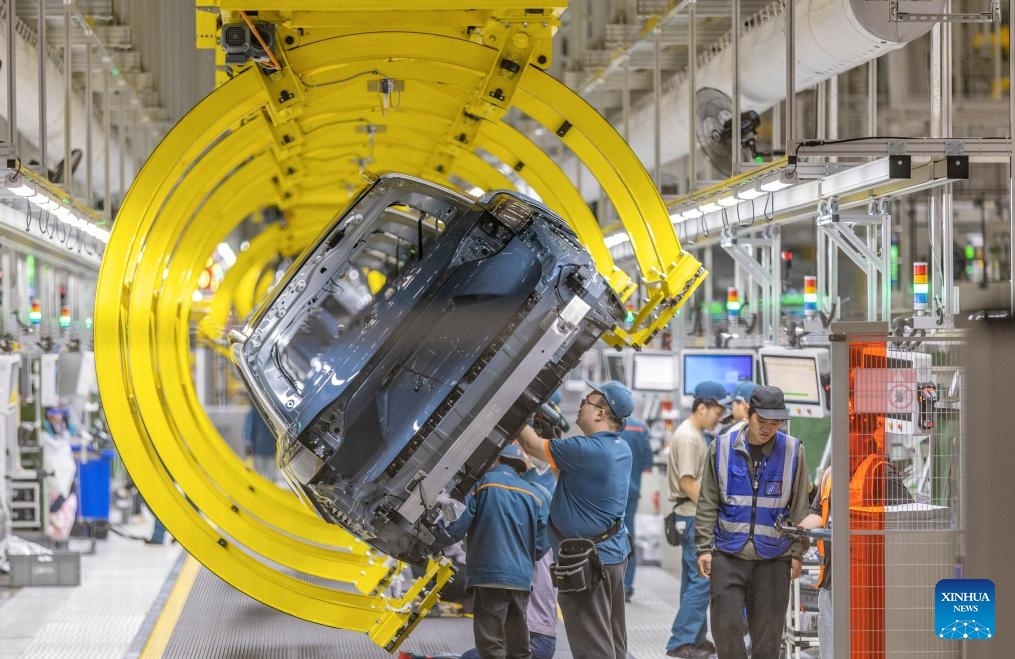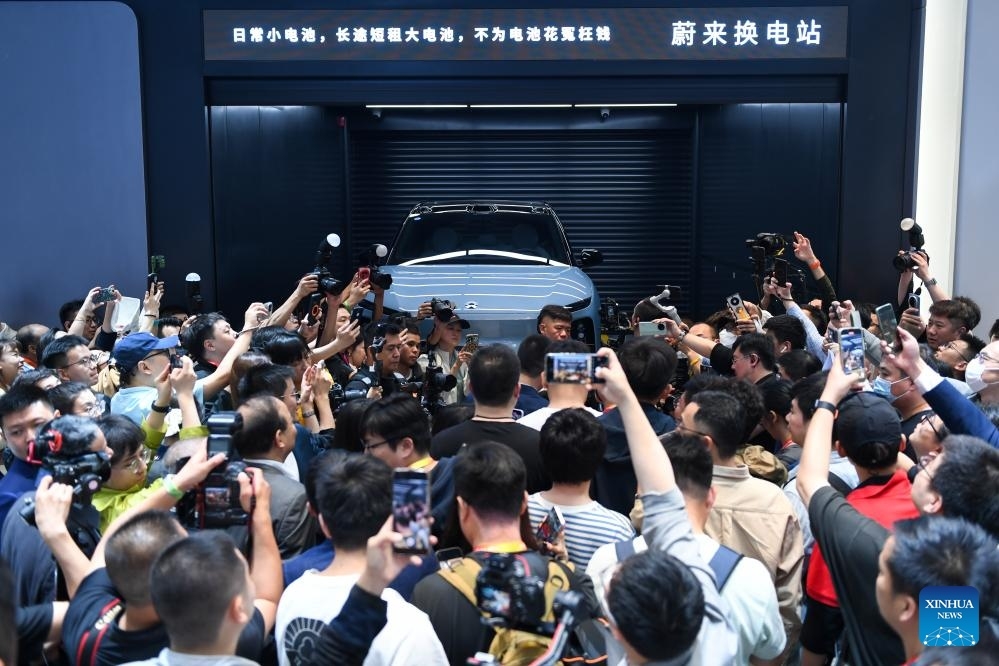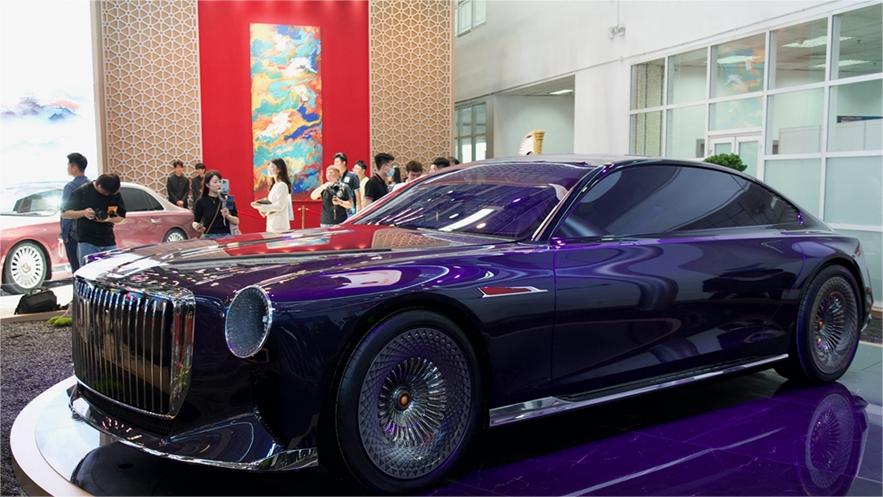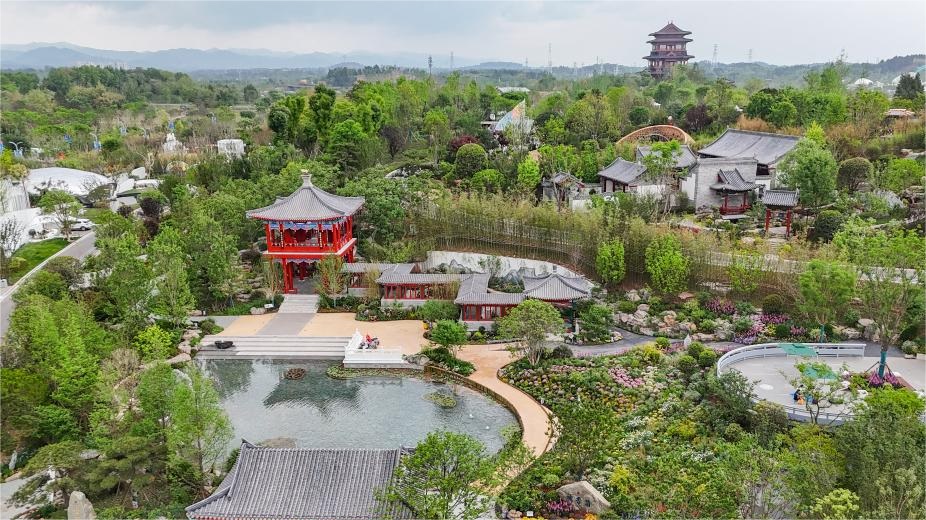Label smearing China's green production capacity is self-defeating in light of facts
For nine consecutive years, China has ranked first in the world in the production and sales of new energy vehicles (NEVs).
China has consistently held the top position in the power batteries market size for eight years and maintained an uninterrupted streak of ten years with the highest installed capacity of photovoltaic power. These achievements highlight the substantial contributions of China’s thriving green industry towards combating climate change, driving global green and low-carbon transformation, and fostering new impetus for global economic growth. Despite these accomplishments, individuals in the US have wrongly labeled China's green production capacity due to subsidy policies and unfair competition advantages.

Workers work at an assembly line of Chinese vehicle manufacturer Seres Group in Liangjiang New Area, Southwest China's Chongqing Municipality, April 25, 2024. (Photo: Xinhua)
These views disregard facts. Anyone who has visited Chinese new energy industry enterprises firsthand and studied the development history of the country's manufacturing industry would know that China's green industry competitive advantages on the international stage result from sincere thinking and solid efforts.
China's honest commitment can be observed through its unwavering dedication to accelerating green and low-carbon development, deepening reform and opening-up, and promoting mutually beneficial cooperation. Likewise, China's substantial efforts are exemplified by its focus on scientific innovation, product optimization and industrial upgrading.
Competitive advantages come from the innovation drives of enterprises and R&D institutions, and establishing such advantages would take years.
More than a decade ago, the global green industry was still in its early stages. Developed countries held advantages in technological reserves and industrial accumulation. At the same time, Chinese companies faced various challenges, such as immature technology and high production costs. However, in the face of these difficulties, Chinese enterprises joined forces and focused on innovation, leading to rapid technological advancements.
Through persistent hard work, Chinese auto companies have achieved significant breakthroughs in intelligent and electrified technologies for NEVs. For instance, they have developed semi-solid-state batteries with a range of 1,000 km on a single charge and 800-volt high-voltage silicon carbide platforms that can ensure a range of 400 km on a five-minute charge. Additionally, they have created automotive smart cockpits incorporating large-scale AI models and urban NOA (Navigate on Autopilot) pilot-assistive driving systems that do not rely on high-precision maps.
Based on his observations, Tawit Thanachanan, the first senior vice president of Thailand's Kasikornbank, has stated that China's emerging industries have gained competitive advantages in the international market in recent years because Chinese companies actively embrace innovation, research and development, and reducing production costs.
Attributing the competitive edge to subsidies dismisses the decades-plus efforts of millions of Chinese green industry technicians and workers.
The competitive advantages come from China's continually improving industrial and supply chain system.
Why can a super factory in Shanghai account for more than half of Tesla’s global capacity? The answer lies in the completeness and efficiency of China’s NEV industry chain. Shanghai provides chips and software; Changzhou in Jiangsu provides power batteries; Ningbo in Zhejiang provides integrated die-casting machines for car bodies; and in the Yangtze River Delta region, a NEV factory can equip all parts within a four-hour drive.
As the world’s leading manufacturing powerhouse, China has a comprehensive industrial category and a well-developed support system. Most materials and components can be sourced from local suppliers, supporting the trial production and mass production of innovative products. As reported by The Diplomat, a Washington-based international online news magazine, compared to Western firms, Chinese EV companies offer advanced technology at competitive pricing, benefiting from their inherent supply chain, which lowers logistics, labor, raw material and transportation costs. The comprehensive supply advantages of a well-established industrial system result from numerous Chinese enterprises’ dedicated development of the real economy.
Attributing the competitive advantage to subsidies ignores the continuous efforts of generations of Chinese people.
The competitive advantages come from the complete opening of China’s vast market.
China has consistently developed its green industry with an open-door policy, encouraging competition. In 2022, China took a significant step by entirely removing foreign investment restrictions in the automotive sector, demonstrating its commitment to further opening-up to the rest of the world.

Visitors watch the demonstration of a battery swap station of Chinese brand NIO at the 2024 Beijing International Automotive Exhibition in Shunyi District, Beijing, capital of China, April 25, 2024. (Photo: Xinhua)
China has embraced foreign brands like Tesla and encouraged newcomers in the auto industry, such as NIO, XPeng and Li Auto, to fully leverage new business models, innovative user operating models and revolutionary product definitions. This has fostered healthy competition between domestic and foreign NEV enterprises in the Chinese market, with these brands competing against and reinforcing one another. Together, they have offered consumers high-tech products and extraordinary user experiences, enhancing the industry’s overall competitiveness.
Attributing the competitive advantage to subsidies also dismisses the efforts of numerous Chinese and foreign new energy enterprises as they strive to earn market support.
Ultimately, the competitive advantages rely on the scientific guidance of new ideas and concepts.
Under the guidance of Xi Jinping’s economic thought, Chinese manufacturing enterprises have faithfully and comprehensively implemented the new development concepts. They have accelerated the establishment of a new development pattern, focused on promoting high-quality development and integrated the ideas of innovation, coordination, greenness, openness and sharing into the configuration of productive factors and the economic development process. These efforts have significantly enhanced resource allocation efficiency and total factor productivity, promoting an optimal combination of high-quality workers and entrepreneurs, intelligent and digital means of production, and a broader range of labor objects. As a result, the industry’s comprehensive strength and enterprise competitiveness have continuously improved.
Guided by the new concept of “new quality productive forces,” Chinese new energy industry enterprises actively adapt to the major trends of intelligent, digital and green transformation triggered by the fourth industrial revolution. They accelerate green technological innovation and the application of low-carbon technologies, resulting in significant achievements in green development.
It is indisputable that China has implemented some industrial policies to promote the development of the green industry. However, such industrial policies are not unique to China.
An article in the South China Morning Post points out that the US and the EU are pioneers and giants in launching state subsidies. In 2022, the US government passed the Inflation Reduction Act, providing about $369 billion in tax incentives and subsidies for industries, including electric vehicles. Several European countries have also implemented subsidy measures for the electric vehicle industry, ranging from corporate taxes to individual purchases.
If this is a common practice, why do some people in certain countries frequently criticize China’s industrial policies?
Their sour grapes attitude should take the blame. China has the advantage of a socialist market economy system, promoting a positive interaction between an effective government and an efficient market. In 2009, after the international financial crisis, China strategically planned deployments to lead future development, proposing cultivating industries such as NEVs as leading and pillar industries and introducing a series of supporting policies. Over the past decade, firm and effective policy measures have created a favorable development environment for emerging industries, helping them to thrive. Seeing China’s success, some people in certain countries inevitably feel envious and rush to use the excuse of subsidies to suppress China.
Their groundless accusations, fueled by an arrogant sense of supremacy, are a clear example of double standards. In recent years, China’s manufacturing industry has gradually expanded from OEM trade to high-value-added segments, steadily advancing to the higher ends of the global industrial chain. This progress, far from being a threat, is a testament to the global benefits of China's industrial development. However, it undoubtedly touches the nerves of specific individuals in certain countries. These people, always concerned that the industrial development of developing countries will cost them opportunities, consistently seek to suppress newcomers by smearing them. The talk of subsidies is merely their latest trick outside the norm.
Scott Lincicome, a trade expert at the Cato Institute in the US, bluntly states that the accusations against China are typical double standards. Wei Qijia, a researcher at China’s State Information Center, believes that the anxiety stems from policy inconsistencies, with “self-contradiction” and “double standards” commonplace. Building walls of trade protectionism interferes with the smooth circulation of the global industrial chain and supply chain, and ultimately, the relevant countries will also suffer the consequences.

Robots work at an assembly line of FAW-Hongqi in Changchun, Northeast China's Jilin Province, April 24, 2024. (Photo: Xinhua)
All things in the world are established in truth, thrive on reality, fail in falsehood and are destroyed by deceit. China has always advocated open cooperation and mutual benefit, never shunning healthy competition. As the global green transformation deepens, a vast market space emerges. In the race track of the new energy industry, the Chinese government and Chinese enterprises, both sincere, persistent and hard-working, will surely advance together with enterprises from other countries, sharing opportunities. Those politicians and individuals who constantly tout “green values” and “free trade” but are not sincere and genuine in promoting green transformation, instead resorting to underhanded tactics to suppress those building and contributing to the response to global climate change and green, low-carbon development, will inevitably face backlash.
(Translated by Lu Dong and Wang Zihui; Edited by Yang Yang)
Photos
Related Stories
- Industrial robot makers gear up for global expansion
- Experts, executives dismiss 'overcapacity' narrative
- Swiss media: Western complaint over 'China's overcapacity' hypocritical, shortsighted
- China flays overseas talk about 'overcapacity'
- How to understand China's production capacity
- The real issue is not overcapacity but competitiveness
Copyright © 2024 People's Daily Online. All Rights Reserved.









